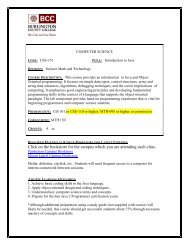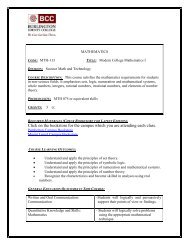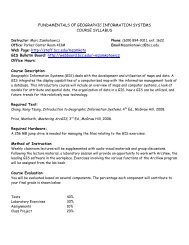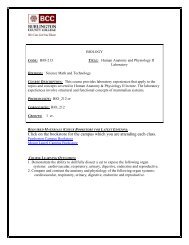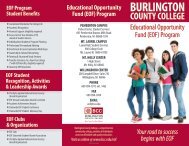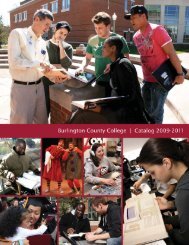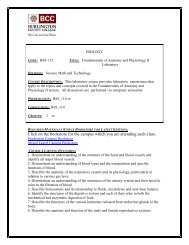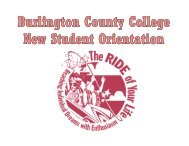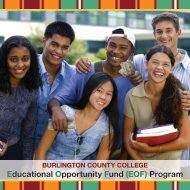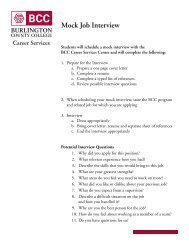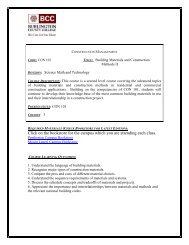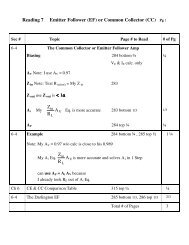Computer Science - Burlington County College
Computer Science - Burlington County College
Computer Science - Burlington County College
You also want an ePaper? Increase the reach of your titles
YUMPU automatically turns print PDFs into web optimized ePapers that Google loves.
Hearing Instrument <strong>Science</strong>s<br />
Associate of Applied <strong>Science</strong>, (AAS.HRS)<br />
The Hearing Instrument <strong>Science</strong>s Program provides both an<br />
academic and clinical experience that will enable students to<br />
develop the knowledge and skills necessary for successful<br />
employment within the spectrum of care, and licensed scope of<br />
practice, of a Hearing Aid Dispenser. Competencies developed will<br />
include the evaluation of the range of human hearing, the making<br />
of ear impressions, the cleaning and alteration of earmolds, the<br />
adaptation of hearing aids, and the physical examination of a<br />
person’s ear in conjunction with the dispensing of hearing aids.<br />
Content areas of the academic component include anatomy<br />
and physiology of the auditory and vestibular systems, communication<br />
and communication disorders, acoustics and psychoacoustics,<br />
auditory rehabilitation, patient counseling and<br />
communication dynamics, and legal and ethical responsibilities.<br />
Experience at the clinical setting and lab is required for<br />
successful completion in competency based clinical areas of<br />
auditory assessment and hearing aid selection, fitting, verification,<br />
outcome assessment and infection control.<br />
The program develops graduates who will provide hearing<br />
healthcare services ethically, and in accordance with State<br />
practice regulations. It is anticipated that graduates would,<br />
upon successful completion of their degree, sit for both the<br />
practical and written state licensing exam. A primary function<br />
of the program is to teach the theoretical background and the<br />
laboratory skills to prepare graduates for successful passage of<br />
their State boards.<br />
Licensed Hearing Instrument Dispensers find a variety of professional<br />
employment opportunities including independent<br />
contracted employment, professional consulting, and the<br />
establishment and the technical support of related professional<br />
and private practice patient services.<br />
Additional Available Benefit<br />
The American Conference on Audioprosthology (ACA) is the<br />
only academic professional recognition in hearing instrument<br />
sciences in the United States. Completion of the Hearing<br />
Instrument <strong>Science</strong>s Program at BCC qualifies a graduate to<br />
apply for ACA designation through the International Institute for<br />
Hearing Instrument Studies. Following a successful clinical<br />
portfolio review by the ACA and the attainment of two years of<br />
professional experience, the BCC Hearing Instrument <strong>Science</strong>s<br />
Program graduate will be entitled to use the professional<br />
designator “ACA” after his or her name.<br />
Interested applicants should obtain a Hearing Instrument<br />
<strong>Science</strong>s Program Admission Information booklet and plan on<br />
attending an information session.<br />
Graduates of this program should be able to:<br />
Demonstrate an understanding of the scope of<br />
professional services provided by Licensed Hearing<br />
Instrument Dispensers;<br />
Establish the best practice of integration of hearing<br />
health care team services for optimum patient outcomes;<br />
www.bcc.edu<br />
Illustrate an understanding of the physical attributes of<br />
sound and their psychological correlates, characteristics<br />
of sound transmission and propagation, ear canal and<br />
earmold acoustics;<br />
Demonstrate an understanding of the basic psychoacoustic<br />
methods and their applications in measuring such auditory<br />
phenomena as threshold, differential sensitivity, frequencypitch<br />
relationships, intensity-loudness relationships,<br />
masking and binaural hearing;<br />
Demonstrate sound practice in acquiring and recording<br />
patient medical histories, including appropriate areas of<br />
inquiry and methods of eliciting information;<br />
Exhibit proper techniques for otoscopy (examining the<br />
external canal and tympanic membrane of the ear),<br />
and for pure tone audiometry including air and bone<br />
conduction, masking, and knowledge of calibration<br />
and infection control techniques;<br />
Display knowledge with the processes of auditory<br />
habilitation and rehabilitation and the role of the<br />
Hearing Instrument Specialist in this process.<br />
General Education Courses † Credits<br />
Written & Oral Communications 6<br />
Mathematics (MTH 113 recommended) 3<br />
Natural <strong>Science</strong> (BIO 110/111 required) 4<br />
Social <strong>Science</strong> (PSY 101 required) 3<br />
Arts & Humanities (PHI 101 required)<br />
Additional General Education Requirements<br />
3<br />
(SOC 101 required) 3<br />
Total 22<br />
† See General Education Requirements on page 43.<br />
Program Courses Credits<br />
HRS 101 Introduction to Applied Hearing <strong>Science</strong>s 1<br />
HRS 110 Acoustics and Psychoacoustics 4<br />
HRS 120 Anatomy and Physiology of the<br />
Auditory and Vestibular Systems 3<br />
HRS 130 Professional Patient Counseling and<br />
Communication Dynamics 3<br />
HRS 140 Communication and<br />
Communication Disorders 3<br />
HRS 150 Legal and Ethical Responsibilities 2<br />
HRS 200 Hearing Assessment I 4<br />
HRS 205 Hearing Assessment II 4<br />
HRS 210 Hearing Instrument Technology I 4<br />
HRS 215 Hearing Instrument Technology II 4<br />
HRS 230 Auditory Rehabilitation 3<br />
HRS 250 Clinical Practicum and Externship 4<br />
Total 39<br />
Electives 3-4<br />
Total Required for Degree 64-65<br />
113




